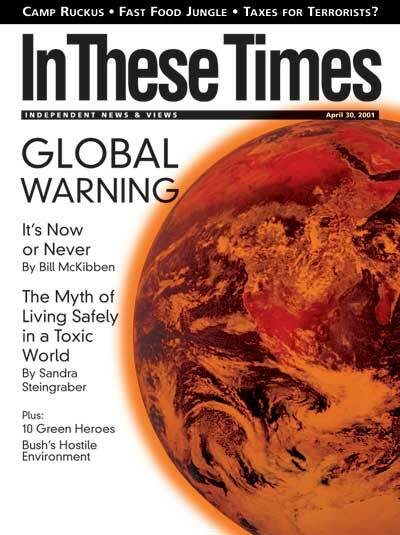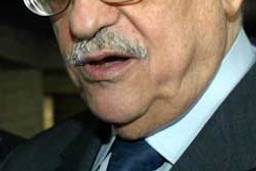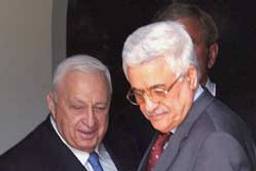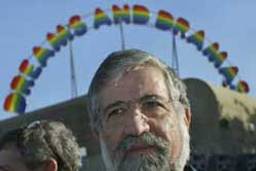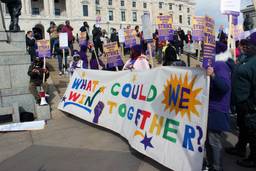A Palestinian in his twenties gets into a taxi at the new Israeli checkpoint set up near the West Bank town of Ramallah. The cars around us roar, straining against the noon-hour bottleneck. The man is so angry that his hands shake as he gives the driver his fare. “I have been sitting here since 9 o’clock,” he says. “The soldiers kept us here because the guy with me shouted at them. But I have now spent half the day getting to work.” His cell phone rings: it’s his boss at the factory asking where he is.
Over the past six months, the West Bank and Gaza Strip have descended into economic crisis. Since late September, Israel has closed off individual Palestinian villages and towns with military checkpoints, cement blocks and deep earthen trenches to prevent Palestinian movement. Justified by the Israeli government as needed to prevent attacks against Israelis, the blockade has stopped the movement of food, workers and Palestinians seeking medical treatment. But it has not stopped the Palestinian uprising against the Israeli occupation.
“Assume that the closures are lifted today,” says Sebastien Dessus, an economist for the World Bank. “It would take years to return to the former situation.” By the end of the year, he says that the percentage of Palestinian poor in the Gaza Strip could rival that of most African nations.
In February, Dessus and a team of World Bank economists completed a report on Palestinian poverty, and the numbers are not encouraging. Three years ago, 23 percent of the 3 million Palestinians fell below a poverty line of $2 a day. But then there was some reason to be hopeful. Many people had moved above that line despite only modest economic growth since peace agreements with Israel. In 1998, the Palestinian economy was improving. Unemployment had dropped to its lowest point in years. Investors were taking the plunge, starting big money ventures like a casino in Jericho and an Intercontinental Hotel in Bethlehem.
Then disaster struck. After six months of the Israeli-imposed closure, the Palestinian economy is in shambles. Israel has sealed Palestinian exits to the outside world, closed off West Bank towns and villages in some 60 areas and partitioned the Gaza Strip into several separate sections. If conditions stay as they are, Dessus says, the percentage of Palestinians in poverty could soon rival that of Bolivia or Sri Lanka. By December, two-thirds of Gaza’s population of more than 1 million will have descended into poverty. The reasons for this impoverishment are clear. Closures have prevented 130,000 people from going to jobs inside Israel. Factories have reduced their production, either because materials are not available or because products cannot be shipped to the market. “Business has dropped by 60 to 70 percent,” says Palestinian economist Samir Abdullah. “Employment in the domestic economy has dropped by 20 percent.”
The natural results of impoverishment are rapidly taking hold. In 1998, the West Bank and Gaza Strip boasted rates of literacy and infant mortality comparable with upper-middle-income countries such as Argentina and Saudi Arabia. Now, according to the U.N. Relief and Works Agency (UNRWA), Palestinians are seeing a 58 percent rise in stillborn births and falling vaccination rates.
“According to our staff, there are quite a number of families cutting out meals,” says Nabil Handal, chief operating officer of Catholic Relief Services, adding that half of the preschool students at CRS-funded schools have dropped out due to the added cost and inability to travel. Next in line are those dropping out of college. And women are increasingly choosing to give birth at home because of the cost and danger in going to a hospital.
“The Israeli policy of collective punishment,” Abdullah explains, “is that they want the Palestinian people to criticize the Palestinian Authority and say that it is doing nothing to mitigate Israeli policies.”
Meanwhile, international relief is pouring in. In February, the Red Cross began to distribute nearly $1 million worth of sugar, tea and personal hygiene items to the 35,000 West Bank families hit hardest by the Israeli blockade. UNRWA, which supports Palestinian refugees, has made a $39 million appeal to funders for employment generation programs. The European Union has put up $60 million to pay 150,000 Palestinian public employees. Even the World Bank has contributed, taking the inordinate step of granting, rather than loaning, $12 million to the Palestinian government. Soon, the U.S. development agency, USAID, will join the chorus, handing out $20 million for job-creation programs in Palestinian areas. “I feel like we are always solving problems that should not have occurred,” says Thomas Neu, director of American Near East Refugee Aid, a recipient of USAID funds. “I think the most important thing right now is to release the siege.”
The U.S. State Department has said that the Israeli closure does “nothing to enhance security in the region,” but has yet to actively confront Israel over its measures against the Palestinians.
Even some Israeli leaders have acknowledged that the closure of Palestinian areas does more harm than good. “This policy cannot protect Israeli citizens from terrorist attacks,” said Ami Ayalon, former head of the Israeli secret service, in a statement to the Israeli press. “On the contrary, this policy will lead the Palestinian society toward further violence and terror.”
Just after Israeli Prime Minister Ariel Sharon took office, a new checkpoint was established between Ramallah and Jerusalem. Traffic was backed up for a mile as Israeli soldiers searched every car and meticulously checked the papers of every driver. Most people abandoned their cars and walked through the checkpoint completely unimpeded, albeit nervous under the guns of a tank parked on the hill. After the new checkpoint made international news, Israel said it had been only trying to catch “terrorists” and that the closure of Ramallah would be eased. Since then, traffic passes more easily through the area, although the rudiments of a checkpoint remain, ready to close the area at any time.
In the face of this, Palestinians remain stalwart. “If there is no pay, people will wait,” Abdullah says. “They will not go to the streets and demonstrate against the Palestinian Authority. But they might go to the checkpoints and fight the Israelis.”
